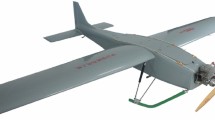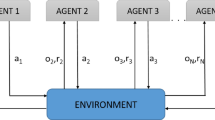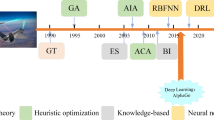Abstract
With the continuous development of society, the universal applicability of Unmanned Aerial Vehicles (UAVs) has gradually emerged, because the facilities, such as surveillance cameras, lifting ropes and manipulators that can be modified are widely used in various fields, and are engaged in various dangerous work beyond the reach of human resources. It is not hard to imagine that in the near future, UAVs would inevitably join in more complex tasks. While UAVs have unique advantages, they also need to pay more attention to maintenance and care to ensure the stability of UAVs in the process of performing tasks and avoid the occurrence of a crash caused by imbalance. For this reason, this paper would set up an automatic balance control method based on Artificial Intelligence (AI) algorithm to study the balance of UAVs with manipulators. Through comparative study with the balance method based on deep learning algorithm, it was found that the method based on AI algorithm can help UAVs better maintain balance. The detection accuracy of the method studied in this paper for UAV flight balance stability was above 96%, and the detection accuracy of UAV automatic balance stability based on deep learning algorithm was below 92%. At the same time, in the face of different influencing factors, the UAV based on artificial intelligence algorithm can also maintain the balance of flight faster and maintain the stability of landing and development flight. Therefore, the research in this paper is meaningful.








Similar content being viewed by others
Data availability
Data sharing not applicable to this article as no datasets were generated or analyzed during the current study.
References
Aggarwal K (2022) Has the future started? The current growth of artificial intelligence, machine learning, and deep learning. Iraqi J Comput Sci Math 3(1):115–123
Chen H, Shang Y, Sun K (2013) Multiple fault condition recognition of gearbox with sequential hypothesis test. Mech Syst Signal Process 40(2):469–482
Cui J, Liu Y, Nallanathan A (2019) Multi-agent reinforcement learning-based resource allocation for UAV networks. IEEE Trans Wirel Commun 19(2):729–743
Fatemidokht H (2021) Efficient and secure routing protocol based on artificial intelligence algorithms with UAV-assisted for vehicular ad hoc networks in intelligent transportation systems. IEEE Trans Intell Transp Syst 22(7):4757–4769
Fu S (2020) Joint unmanned aerial vehicle (UAV) deployment and power control for internet of things networks. IEEE Trans Veh Technol 69(4):4367–4378
He X (2018) Rapid development of unmanned aerial vehicles (UAV) for plant protection and application technology in China. Outlooks Pest Manag 29(4):162–167
Kim MJ, Konstantin K, Christian O (2018) A stabilizing controller for regulation of uav with manipulator. IEEE Robot Autom Lett 33:1719–1726
Liu Y (2018) A distributed control approach to formation balancing and maneuvering of multiple multirotor UAVs. IEEE Trans Rob 34(4):870–882
Liu X (2020) Artificial intelligence aided next-generation networks relying on UAVs. IEEE Wirel Commun 28(1):120–127
Otto A (2018) Optimization approaches for civil applications of unmanned aerial vehicles (UAVs) or aerial drones: a survey. Networks 72(4):411–458
Ramachandran A, Sangaiah AK (2021) A review on object detection in unmanned aerial vehicle surveillance. Int J Cogn Comput Eng 2:215–228
Siddiqi MA (2022) Analysis on security-related concerns of unmanned aerial vehicle: attacks, limitations, and recommendations. Math Biosci Eng 19(3):2641–2670
Wang C (2018) Testing method and distribution characteristics of spatial pesticide spraying deposition quality balance for unmanned aerial vehicle. Int J Agric Biol Eng 11(2):18–26
Wang Q, Dai HN, Wang H, Xu G, Sangaiah AK (2019) UAV-enabled friendly jamming scheme to secure industrial Internet of Things. J Commun Netw 21(5):481–490
Weixi W, Xiaoming L, Linfu X, Haibin L, Zhihan L (2021) Unmanned aircraft system airspace structure and safety measures based on spatial digital twins. IEEE Trans Intell Transp Syst 23(3):2809–2818
Wu J, Tao R, Zhao P, Martin NF, Hovakimyan N (2022) Optimizing nitrogen management with deep reinforcement learning and crop simulations. In: Proceedings of the IEEE/CVF conference on computer vision and pattern recognition. 1712–1720
Yang L (2020) Multi-UAV-enabled load-balance mobile-edge computing for IoT networks. IEEE Internet Things J 7(8):6898–6908
Yu C, Li Z, Yang D, Liu H (2022) A fast robotic arm gravity compensation updating approach for industrial application using sparse selection and reconstruction. Robot Auton Syst 149:103971
Yuan J, Zhao M, Esmaeili-Falak M (2022) A comparative study on predicting the rapid chloride permeability of self-compacting concrete using meta-heuristic algorithm and artificial intelligence techniques. Struct Concr 23(2):753–774
Zeybek M (2021) Classification of UAV point clouds by random forest machine learning algorithm. Turkish J Eng 5(2):48–57
Zhou X, Liang X, Du X, Zhao J (2018) Structure based user identification across social networks. IEEE Trans Knowl Data Eng 30(6):1178–1191
Funding
This research is made possible via REIG Grant by UCSI University under REIG-FETBE-2022/053.
Author information
Authors and Affiliations
Corresponding author
Ethics declarations
Conflict of interest
The authors declare that there is no conflict of interest with any financial organizations regarding the material reported in this manuscript.
Ethical approval
This study does not violate and does not involve moral and ethical statement. Ethical approval for this study and written informed consent from the participants of the study were not required in accordance with local legislation and national guidelines.
Additional information
Publisher's Note
Springer Nature remains neutral with regard to jurisdictional claims in published maps and institutional affiliations.
Rights and permissions
Springer Nature or its licensor (e.g. a society or other partner) holds exclusive rights to this article under a publishing agreement with the author(s) or other rightsholder(s); author self-archiving of the accepted manuscript version of this article is solely governed by the terms of such publishing agreement and applicable law.
About this article
Cite this article
Li, Q., Xing, D., Ilyas, M.A. et al. Autonomous balance control method of unmanned aerial vehicle with manipulator based on artificial intelligence algorithm. Soft Comput (2023). https://doi.org/10.1007/s00500-023-08485-2
Accepted:
Published:
DOI: https://doi.org/10.1007/s00500-023-08485-2




